Last Saturday marked the official opening of the Dutchess Rail Trail, and festivities were held in Hopewell Junction to celebrate this newly completed “linear park.” Though the event focused on the dedication of the rail trail to former County Executive William R. Steinhaus, it is impossible to miss the newly-restored depot just steps away. After many years of lying vacant, and even being burned by arsonists, the depot was eventually restored to greatness. The depot lies at the east end of the trail, and will serve as a welcome center for visitors.
Hopewell has a long history of railroading – the first railroad to arrive was the Dutchess and Columbia in 1871. It was followed by the New York & New England’s line in 1881. The first railroad crossing over the Hudson River south of Albany opened in Poughkeepsie in 1888, leading to additional traffic through Hopewell. That link formed the “Maybrook Line,” which is now the Dutchess Rail Trail.
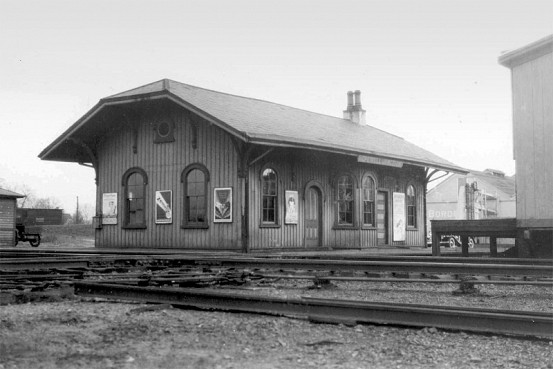 Â
 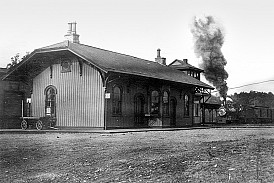 Â
  Â
 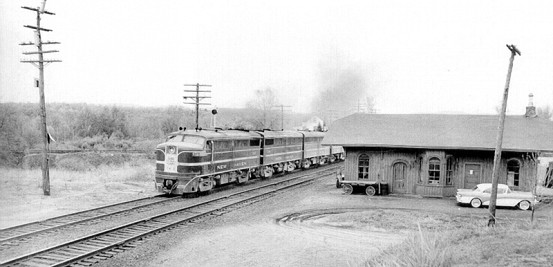 Â
 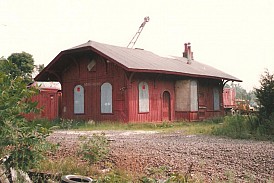 Â
 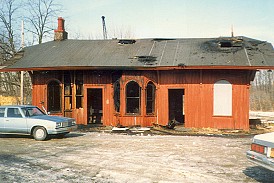 Â
 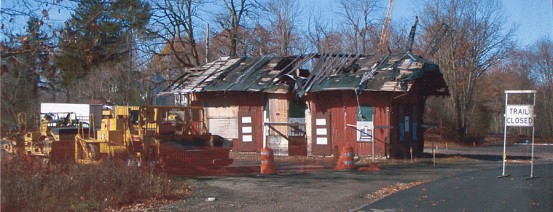
Historical views of Hopewell Junction depot. All photos via the Hopewell Junction Restoration Corp.
Saturday’s festivities also marked an unofficial event for the Depot – the first opening of what I call the “museum room.” Over the past few months, I worked with other volunteers to design four interpretive panels highlighting the history of local railroading through Hopewell, and its impact on the community. All four panels were completed, printed, and hung for the rail trail event.

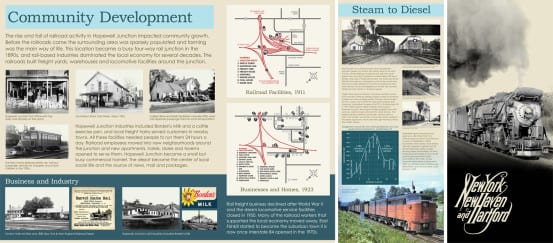
These are the interpretive panels now on display at Hopewell Junction
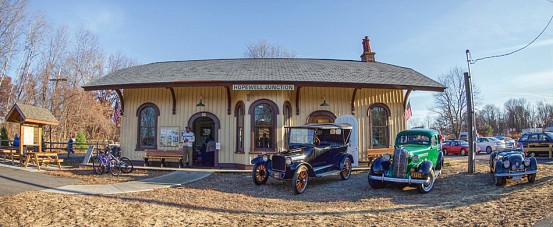 Â
 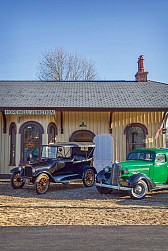 Â
 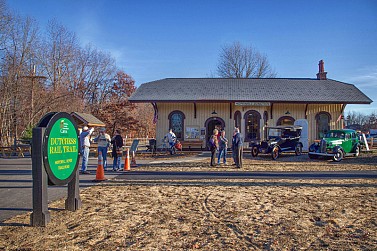 Â
 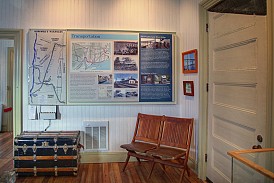 Â
 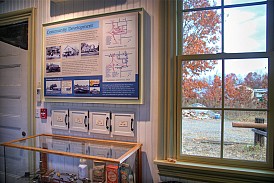 Â
 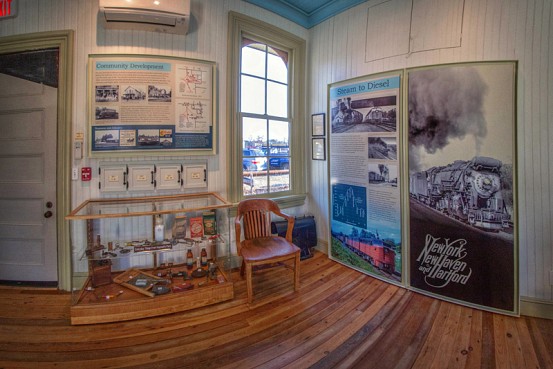 Â
 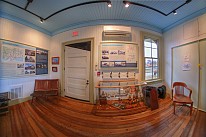 Â
  Â
 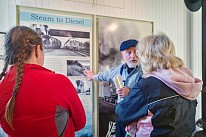
The restored Hopewell Junction Depot and the new interpretive panels on display.
In all, the Dutchess Rail Trail opening was a lovely event, and heavily attended. Hopewell Junction is now connected by trail to the Walkway Over the Hudson, which is an attractive journey.
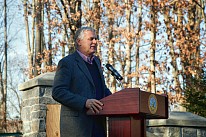 Â
  Â
 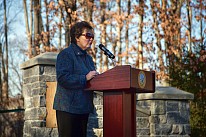 Â
 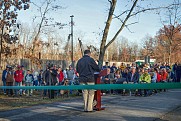 Â
 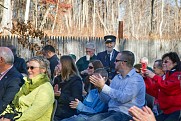 Â
 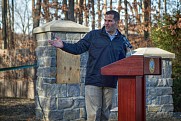 Â
 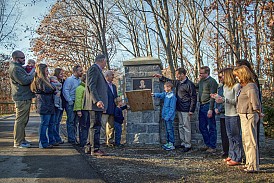 Â
 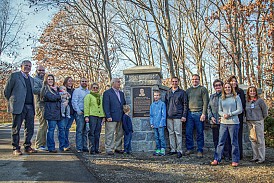 Â
 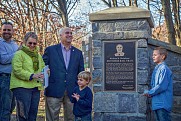 Â
 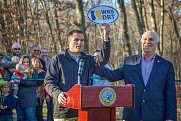 Â
 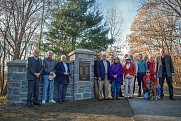 Â
 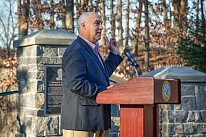 Â
  Â
 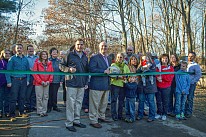 Â
 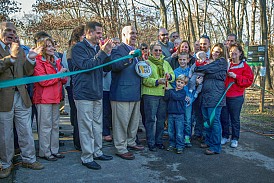 Â
 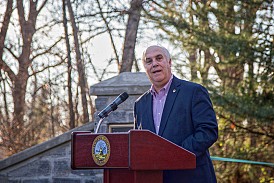 Â
 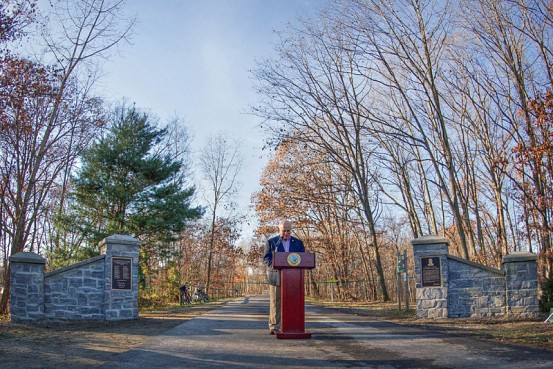
Photos from the opening of the Dutchess Rail Trail
While some of the most die-hard railfans are sometimes against the conversion of rail lines into rail trails, I am generally in support of rail trails due to the fact that they preserve the history of abandoned rail lines. The original concept behind rail trails was railbanking – essentially preserving the railroad’s right of way in case there would be reactivation in the future. In practice, however, railbanking by converting to trails is at best a scam, and at worst an acceptable to way to grab land, or a method to support the trucking industry by ensuring that competition by rail freight will never be restored. Once the right of way is converted to a trail, turning it back into a rail line is almost impossible, or as Metro-North President Howard Permut said regarding reactivating the Harlem Line up to Millerton, “how do you de-map a rail trail?” Although the Rails to Trails Conservancy admits its origins in the concept of railbanking, they have little regard for railroads. In fact their 2011 annual report celebrates a victory in preventing a rail line from reactivating service – and we’re talking about a rail line that still had tracks on the ground, and had not been turned into a trail.
Alas, this is the reality of the United States, where the car reigns supreme, and few realize the true benefits of railroads. Many railfans tend to believe in the fairy tale that all former rail lines could be reborn, but that will never happen. In instances where a revival of train service will probably never happen, I support turning these lines into trails to preserve their history. Considering that the actual rails where the Dutchess Rail Trail now sits were gone even before I was born, an entire generation grew up with almost no clue that a railroad had been there. The line remained abandoned and forgotten for decades before being developed into a trail. At least the rail trail preserves its memory. The Dutchess Rail Trail and the recently restored Hopewell Junction depot, serving as the east trailhead for it, are like a match made in heaven. In tandem, the depot (and its new museum room, with historical interpretive panels) and the trail will ensure that generations to come remember the history of this once proud rail line, and its service as a gateway to New England. It is the perfect embodiment of the pure rails to trails concept: “protecting and converting America’s unused rail corridors for multi-use trails.”
Unfortunately, the once-laudable concept of preservation by saving abandoned rail corridors has been perverted. Instead of saving abandoned corridors, trail proponents have set their sights on driving out existing railroads and claim the right of way for themselves (the Rails to Trails Conservancy’s how-to Acquiring Rail Corridors guides would-be vultures to circle existing railroads until they die). Two New York Rail lines – the Catskill Mountain Railroad, and the Adirondack Scenic Railroad – are both under fire from politicians and an extremely vocal group of trail proponents that want them gone by any means (including committing felonies and vandalism). The most serious case is the Catskill Mountain Railroad – a successful all-volunteer operation that attracts visitors from around the state and beyond to ride its scenic trains. While I credit former Dutchess County Executive Steinhaus for his role in preserving history on both the Dutchess and Harlem Rail Trails, it seems that Ulster County Executive Mike Hein is green with jealousy, and foaming at the mouth to get his own rail trail, even if it means taking down an active railroad in the process. Mr. Hein, I think you miss the point, we’re supposed to be preserving history, not demolishing it.
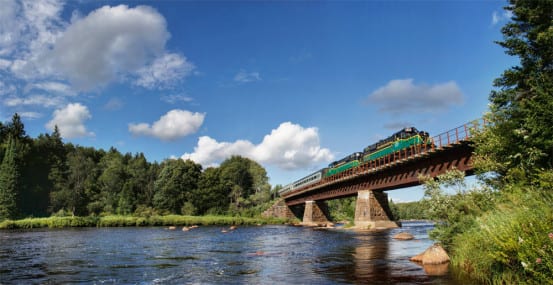
Advocates for rail trails seek to shut down the Catskill Mountain Railroad and the Adirondack Scenic Railroad (pictured above) and turn them into trails.
Hein has promoted tourism to Ulster County (conveniently, the agency engaged in this promotion is a financial donor to Mr. Hein), yet seeks to take down a railroad that does in fact attract tourists, all of which is run by volunteers with no cost to the county. Rail trails are certainly in vogue these days and popping up everywhere – so why would any tourists travel to Ulster just for a trail, when they could visit one closer to home? An economic impact analysis of the rail trail plan, with grossly inflated numbers, compares the proposed trail with the Walkway over the Hudson. No offense, Mr. Hein, but that is apples to oranges – the Walkway is a unique creation, and undoubtedly draws tourists for that exhilarating experience of walking across the mighty Hudson. A trail in the Catskills wouldn’t attract anywhere close to the visitors that the Walkway receives.
If any of you out there like the Dutchess or other rail trails, and you support the actual preservation of history, go lend a hand to the Catskill Mountain Railroad, which desperately needs financial support. They support rails WITH trails – a no brainer solution.
Why demolish an active rail line when the county could easily create a trail alongside it? Because a rail with trail “decreases the usefulness” of a trail, will lead to safety issues for the railroad, and will increase costs? That is grasping at straws. Why should anyone trust anything the county has to say in their report, especially when cited public estimations of fixing a bridge on the line were more than $850,000 dollars, yet the railroad repaired it with volunteers for under $30,000? As for safety, the Rails to Trails Conservancy’s 2000 study, as cited by the US Department of Transportation, found that Rails with Trails “are compatible with active railroads” and “are just as safe as other trails.” So really, why does Hein refuse to consider a rail and trail? Is it an ego thing, or has another company or PAC that donates money to Mr. Hein yet again greased the wheels?
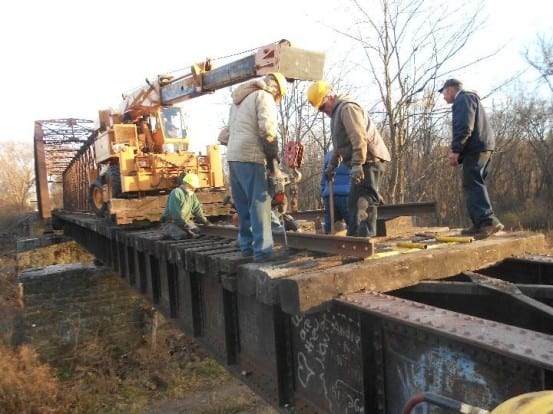
Hein & Friends like to depict the Catskill Mountain Railroad as a failure by showing photos of Hurricane Irene damage. Even established railroads like Metro-North were heavily damaged by this storm. In reality, volunteers repaired the storm damage and more without the FEMA funding earmarked for it, as Mike Hein refuses to disburse it.
Support rails with trails, and preservation of our history. That would make a real world-class tourist attraction.



Just in the past two months I have visited successful operations where rails and trails exist side-by-side. Interestingly, both lines have daily train service throughout most of the year, so trains passing hikers and bikers is nothing unusual. The Western Maryland Scenic in Cumberland, Md., occupies the former Western Maryland right-of-way to Frostburg, and for years this piece of the otherwise abandoned WM was a missing link in a trail from the Washington, D.C., area to the Pittsburgh area. Alleghany County worked with the railroad and the trail people to help fill in the missing link of the trail while keeping rail service. Likewise, the new Steam Into History operation in New Freedom, Pa., has just opened this year with an 1860s-replica steam locomotive hauling vintage cars on a route that Abraham Lincoln took to Gettysburg, with an established trail running alongside. As these two examples how, it doesn’t matter if the railroad or the trail was there first — they can coexist.
Another example is in Sacramento, California where a trail and the Sacramento Southern tourist railroad exist side-by-side. It seems to work well there. It would work well in Ulster County too.
As a one-time resident of Poughquag, I can recall watching the NH climbing the hill up from Green Haven and disappearing in the cut. My recollection of Hopewell Junction (we always called it Hopeless) is of a slightly different depot, which was still in service in 1963-64. Was there another building at that junction?
No mention of Bernie Rudberg, Emily? I don’t think the Hopewell Depot project would have gotten anywhere without him. Anyway, you will be happy to know that he linked over to here in a post on the New Haven Railroad forum.
Aww, you mean the photo of Bernie in his Conductor hat wasn’t enough? ;)
Believe me, there are plenty of things that I could have said about Hopewell, but kept it short to address the rails to trails thing. Plus, I think everybody should get their butts over to Hopewell!
Thanks for discussing this. It’s been very upsetting the way the “Rails-to-trails conservancy” has been perverted into an anti-rail, anti-conservation, pave-it-with-asphalt-and-drive-cars operation.
The scheme for destroying the Woodinville Subdivision in the Seattle area is going to have nasty long-term consequences, as it’s the only north-south connecting rail route west of Spokane and east of the waterfront, and the line along the waterfront is threatened by mudslides and rising seas. This is a scheme which a lot of villains have had their hands in, starting with the state roads department (I mean “department of transportation”).
The situation with the Catskill Mountain Railroad is the most egregious, of course.
The Adirondack Scenic is protected to some extent by support from the state government and several local governments. But the anti-rail nuts in the Adirondacks are not above lying through their teeth — which they have done repeatedly — in addition to the vandalism. They are suspected of not actually wanting a trail at all. While it’s a great rail route, it would be a completely unusable trail, wandering through the “forever wild” parts of the Adirondack Park for over 30 miles without access points.
In Santa Fe NM,there’s a trail that follows the NMRX/Santa Fe Southern ROW from
the Railyard till just east of Rodeo Road near CP Hondo,in some places using the
former ATSF Branch ROW(in an area near Zia Road).
The “Rail Trail” is a part of an interconnected bike/walk trail network in the city
of Santa Fe,regreatbly,the Santa Fe Southern has been “mothballed” due to
the lack of freight and the local economy is still somewhat depressed.
NMRX runs daily except for some holidays.
Thanks for addressing the rail to trails issue.
The Adirondack Scenic is a beautiful line, and I’d hate to see the Lake Placid operation come to an end (although the trail groups somehow claim the line segment they want isn’t in use/needed) because of the inability to move equipment back to Utica for service.
What we really need to do is start a legal fund to defend the operators of these economic engines. I’m a cyclist, but in reality I wouldn’t have any use for that segment, it’s too far from anything resembling emergency services. Besides bike paths usually become homes for drug dealers and rapists (at least here in WNY) due to lack of law enforcement.
It’s a damn shame.
I can operate, professionally, a CAT D-9 bulldozer, and would be glad to volunteer my time on one (D-8s, D-6s, and D-4s acceptable) between Wassaic and Millerton, and north (west) ward to Chatham. Even a JD-350, or JD-450 would work for me!) Screw the Yuppies! Would have to hose down the lags every day to get the
‘Labrador Landmines’ out of the treads, not to mention disposable diapers and plastic water containers.
Does anyone know when the “Fleetwood” (Mount Vernon) NYC station was put into service?
There is no valid reason why there should not be a rail line in that town today. It was because of corrupt politics that the line was stolen.
Rail with Trail is a no brainer. Just like a sidewalk next to a road.
Mr. Dawson, your final remark is so brilliant I’d like to know if I can quote that. I volunteer on the CMRR and I’m passionate about building the trail parallel to the railroad. You could not have said it more perfectly.